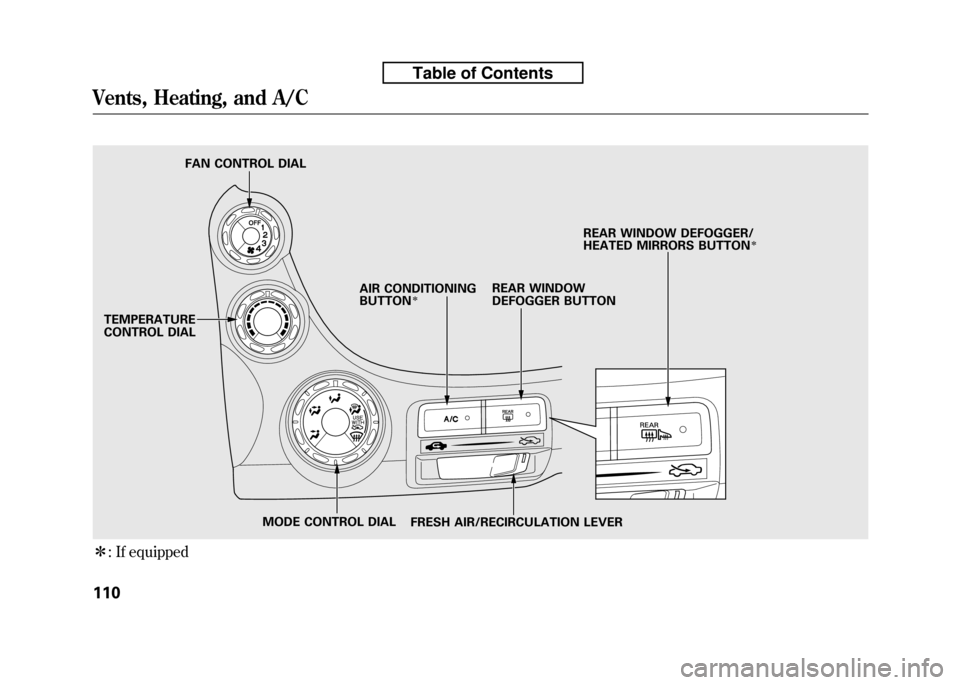2010 HONDA FIT air condition
[x] Cancel search: air conditionPage 1 of 351

A
Accessories andModifications ..........................
206
ACCESSORY (Ignition Key Position) ...................................
80
Accessory Power Socket ............
106
Additives, Engine Oil .................
254
Adjusting the Steering Wheel ......
77
Advanced Airbags ........................
27
Airbag (SRS) ............................
9, 22
Air Conditioning System ............
110
Usage ......................................
112
Air Pressure, Tires ..............
273, 274
Alcohol in Gasoline ....................
198
Antifreeze ...................................
256
Anti-lock Brakes (ABS) Indicator ............................
62, 231
Operation ................................
231
Anti-theft, Audio System .............
191
Anti-theft Steering Column Lock .........................................
80
Audio Antenna ...........................
268
Auto Door Locking .......................
83
Auto Door Locking/Unlocking ....
83 Auto Door Unlocking
...................
85
Automatic Seat Belt Tensioners ...
20
Automatic Speed Control ...........
194
Automatic Transmission ............
219
Capacity, Fluid ........................
319
Checking Fluid Level ..............
259
Paddle Shifters ........................
224
Shifting ...................................
219
Shift Lever Position Indicators ............................
219
Shift Lever Positions ...............
220
Shift Lock Release ...................
223
Automatic Transmission Fluid ...
259
Auxiliary Input Jack ...................
190
Average Fuel Economy ................
70
B
Battery Charging System Indicator ........................
60, 303
Jump Starting ..........................
299
Maintenance ...........................
279
Specifications ..........................
320
Before Driving ...........................
197Belts, Seat
................................ 8, 18
Beverage Holders ......................
106
Booster Seats ...............................
50
Brakes Anti-lock Brakes (ABS) ...........
231
Break-in, New Linings .............
198
Bulb Replacement ...................
266
Fluid .......................................
261
Parking ...................................
102
System Design ........................
230
System Indicator ...............
60, 305
Wear Indicators .......................
230
Braking System ..........................
230
Break-in, New Vehicle ................
198
Brightness Control, Instruments ..............................
76
CONTINUED
Index
I
INDEX
Page 18 of 351

Contents
A convenient reference to the
sections in this manual.
Your Vehicle at a Glance
A quick reference to the main
controls in your vehicle.
Driver and Passenger Safety
Important information about the
proper use and care of your vehicle's
seat belts, an overview of the
supplemental restraint system, and
valuable information on how to
protect children with child restraints.
Instruments and Controls
Explains the purpose of each
instrument panel indicator and
gauge, and how to use the controls
on the dashboard and steeringcolumn. Features
How to operate the heating and air
conditioning system, the audio
system, and other conveniencefeatures.Before Driving
What gasoline to use, how to break-
in your new vehicle, and how to load
luggage and other cargo. Driving
The proper way to start the engine,
shift the transmission, and park. Maintenance
The maintenance minder shows you
when you need to take your vehicle
to the dealer for maintenance
service. There is also a list of things
to check and instructions on how to
check them.
Taking Care of the Unexpected
This section covers several problems
motorists sometimes experience, and
details how to handle them.
Technical Information
ID numbers, dimensions, capacities,
and technical information.
Warranty and Customer Relations
(U.S. and Canada only)
A summary of the warranties
covering your new vehicle, and how
to contact us for any reason. Refer to
your warranty manual for detailedinformation. Index
Service Information Summary
A summary of the information you
need when you pull up to the fuelpump.
Overview of Contents
2
Page 22 of 351

You'll find many safety
recommendations throughout this
section, and throughout this manual.
The recommendations on this page are
the ones we consider to be the most important.
Always Wear Your Seat Belt
A seat belt is your best protection in all
types of collisions. Airbags are designed
to supplement seat belts, not replace
them. So even though your vehicle is
equipped with airbags, make sure you
and your passengers always wear your
seat belts, and wear them properly (see
page 14).
Restrain All Children
Children age 12 and under should ride
properly restrained in a back seat, not
the front seat. Infants and small children
should be restrained in a child seat.
Larger children should use a booster
seat and a lap/shoulder belt until they
can use the belt properly without a
booster seat (see pages 34-52). Be Aware of Airbag Hazards
While airbags can save lives, they can
cause serious or fatal injuries to
occupants who sit too close to them, or
are not properly restrained. Infants,
young children, and short adults are at
the greatest risk. Be sure to follow all
instructions and warnings in this manual.
Don't Drink and Drive
Alcohol and driving don't mix. Even one
drink can reduce your ability to respond
to changing conditions, and your
reaction time gets worse with every
additional drink. So don't drink and
drive, and don't let your friends drink
and drive, either.
Pay Appropriate Attention to the
Task of Driving Safely
Engaging in mobile phone conversation
or other activities that keep you from
paying close attention to the road, other
vehicles and pedestrians could lead to
crash. Remenber, situations can change
quickly, and only you can decide when it
is safe to divert attention away from driving. Control Your Speed
Excessive speed is a major factor in
crash injuries and deaths. Generally, the
higher the speed, the greater the risk,
but serious injuries can also occur at
lower speeds. Never drive faster than is
safe for current conditions, regardless of
the maximum speed posted.
Keep Your Vehicle in Safe Condition
Having a tire blowout or a mechanical
failure can be extremely hazardous. To
reduce the possibility of such problems,
check your tire pressures and condition
frequently, and perform all regularly
scheduled maintenance (see page 245).
Important Safety Precautions
6
Table of Contents
Page 36 of 351

Automatic Seat Belt Tensioners
For added protection, the front seat
belts are equipped with automatic
seat belt tensioners. When activated,
the tensioners immediately tighten
the belts to help hold the driver and a
front passenger in position.The tensioners are designed to
activate in any collision severe
enough to cause the front airbags todeploy.
If a side curtain airbag deploys
during a side impact, the tensioner
on that side of the vehicle will alsodeploy.
The tensioners can also be activated
during a collision in which the frontairbags
do not deploy. In this case, the
airbags would not be needed, but the
extra tension in the seat belt could behelpful.
When the tensioners are activated,
the seat belts will remain tight until
they are unbuckled. Seat Belt Maintenance
For safety, you should check the
condition of your seat belts regularly.
Pull each belt out fully, and look for
frays, cuts, burns, and wear. Check
that the latches work smoothly and
the belts retract easily. If a belt does
not retract easily, cleaning the belt
may correct the problem (see page
267). Any belt that is not in good
condition or working properly will
not provide good protection and
should be replaced as soon aspossible.
Honda provides a limited warranty
on seat belts. See your
Honda
Warranty Information
booklet for
details.
Additional Information About Your Seat Belts
20
Table of Contents
Page 69 of 351

Your vehicle's exhaust contains
carbon monoxide gas. Carbon
monoxide should not enter the
vehicle in normal driving if you
maintain your vehicle properly and
follow the information on this page.
Have the exhaust system inspected
for leaks whenever:● The vehicle is raised for an oilchange.
● You notice a change in the sound
of the exhaust.
● The vehicle was in a collision that
may have damaged the underside.
Carbon monoxide gas is toxic.
Breathing it can cause
unconsciousness and even killyou.
Avoid any enclosed areas or
activities that expose you to
carbon monoxide.
High levels of carbon monoxide can
collect rapidly in enclosed areas,
such as a garage. Do not run the
engine with the garage door closed.
Even with the door open, run the
engine only long enough to move the
vehicle out of the garage. With the tailgate open, airflow can
pull exhaust gas into your vehicle's
interior and create a hazardous
condition. If you must drive with the
tailgate open, open all the windows
and set the heating and cooling
system as shown below.
If you must sit in your parked vehicle
with the engine running, even in an
unconfined area, adjust the heating
and cooling system as follows:
1. Select the fresh air mode.
2. Select the
mode.
3. Turn the fan on high speed.
4. Set the temperature control to a comfortable setting.
Carbon Monoxide Hazard
53
Driver and Passenger Safety
Table of Contents
Page 124 of 351

The heating and air conditioning
system in your vehicle provides a
comfortable driving environment in
all weather conditions.
The standard audio system has many
features. This section describes
those features and how to use them.
Your vehicle has an anti-theft audio
system that requires a code number
to enable it.
The security system helps to
discourage vandalism and theft of
your vehicle.Vents, Heating, and A/C.............
110
Playing the FM/AM Radio (Models without navigationsystem) ...............................
115
Playing a Disc (Models without navigation system) ..................
122
Disc Player Error Messages (Models without navigationsystem) ...............................
128
Playing an iPod
®(Models without
navigation system) ..................
129
iPod
®Error Messages (Models
without navigation system) .....
135
Playing a USB Flash Memory Device (Models without
navigation system) ..............
136
USB Flash Memory Device Error
Messages (Models withoutnavigation system) ..............
142
Playing the AM/FM Radio
(Models with navigation
system) ...............................
143
Playing a Disc (Models with
navigation system) ..................
149Disc Player Error Messages
(Models with navigation
system) ...............................
157
Playing a PC card (Models with
navigation system) ..................
158
Playing an iPod
®(Models with
navigation system) ..................
170
iPod
®Error Messages (Models
with navigation system) ..........
176
Playing a USB Flash Memory
Device (Models withnavigation system) ..............
177
USB Flash Memory Device Error Messages (Models withnavigation system) ..............
183
FM/AM Radio Reception ............
184
Protecting Your Discs .................
186
Remote Audio Controls ...............
189
Auxiliary Input Jack ....................
190
Radio Theft Protection ................
191
Setting the Clock .........................
192
Security System ..........................
193
Cruise Control ............................
194
Features
109
Features
Page 125 of 351

ꭧ: If equipped
TEMPERATURE
CONTROL DIAL FAN CONTROL DIAL
REAR WINDOW
DEFOGGER BUTTON
AIR CONDITIONINGBUTTON
ꭧ
FRESH AIR/RECIRCULATION LEVER REAR WINDOW DEFOGGER/
HEATED MIRRORS BUTTON
ꭧ
MODE CONTROL DIAL
Vents, Heating, and A/C
110
Table of Contents
Page 126 of 351

Airflow Controls
Fan Control Dial
Turn this dial to increase or decrease
the fan speed and airflow.
Temperature Control Dial
Turning this dial clockwise increases
the temperature of the airflow.
Air Conditioning (A/C) Button
If equipped
This button turns the air
conditioning on and off. The
indicator in the button is on when the
A/C is on.
Fresh Air/Recirculation Lever
This lever controls the source of the
air going into the system. When you
slide the lever to the
side, air is
brought in from outside the vehicle
(fresh air mode). When you selectthe
side, air from the vehicle's
interior is sent through the system
again (recirculation mode). The outside air intakes for the
heating and cooling system are at the
base of the windshield. Keep this
area clear of leaves and other debris.
The system should be left in fresh air
mode under almost all conditions.
Keeping the system in recirculation
mode, particularly with the A/C off,
can cause the windows to fog up.
Switch to recirculation mode when
driving through dusty or smoky
conditions, then return to fresh airmode.
Rear Window Defogger Button
/
This button turns the rear window
defogger on and off (see page 76).
On some models, this button also
operates the heated outside mirrors
(see page 102).
Mode Control Dial
Use the mode control dial to select
the vents the air flows from. Some air
will flow from the dashboard corner
vents in all modes.
Air flows from the center and
corner vents in the dashboard.
Airflow is divided between the
vents in the dashboard and the floor vents.
Air flows from the floor vents.
Airflow is divided between the
floor vents and defroster vents at the
base of the windshield.
Air flows from the defroster
vents at the base of the windshield.
CONTINUED
Vents, Heating, and A/C
111
Features
Table of Contents